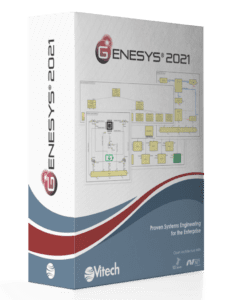BLACKSBURG, VA, USA – Vitech has announced the release of GENESYS™ 2021, the latest version of its model-based systems engineering development platform. This release brings a range of added features that enhance efficiency, accuracy, and flexibility—all in the service of greater analytical power for the engineer.
“Today’s complex systems require highly refined capabilities in accurately capturing requirements, architectures, and relationships throughout a product lifecycle,” said David Long, President of Vitech. “GENESYS 2021 does this with even greater richness than previous versions, giving the engineer tremendous analytical power. With these capabilities, you can better combine architecture to manage complexity with the analysis required to engineer with rigor.”
Streamlined creation and maintenance of architectures

GENESYS has long supported the object-oriented concept of inheritance, as users tailor and extend the information model used to analyze and specify their system of interest. With entity-level inheritance, GENESYS 2021 enables users to apply these same concepts to the architecture itself. Users can now model objects specifying attributes, parameters, and properties once, and then inherit, specialize, and extend these entities based upon need. The result is a powerful yet flexible framework enabling users to rapidly model both general and specialized ideas, avoiding duplication of work and allowing for the streamlining of updates as well as simplifying reuse.
Increased clarity and avoidance of errors through enhanced parameters
Parameters play a key role in the requirements, design, and verification of systems. In classical document-centric engineering, these numerics of design are embedded within textual statements. GENESYS exposes these values for enhanced management and analysis while maintaining the natural language statements used by many engineers, delivering an integrated system for human and computer reasoning. GENESYS 2021 enhances the specification and management of these critical values, bringing unprecedented power to the specification and analysis of systems.
GENESYS 2021 extends the fields associated with each parameter, providing greater richness and flexibility in requirements, design, and verification. Users can now specify objectives, minimum, and maximum values to define valid ranges as well as precision to better reflect requirements, architecture, and test. Project teams control which fields to display, allowing teams to tailor parameters to meet their specific needs.
Even more powerful is the ability to bind parameters together, clearly reflecting dependencies and avoiding manual translation errors. Critical requirements values can be bound directly to architecture and test, enabling the team to understand their current status while rapidly responding to changes in requirements or design. When combined with software ranging from MATLAB to ModelCenter MBSE, the result is enhanced analytical rigor driven and connected by the descriptive architecture.
An enhanced MBSE experience
While focused on greater analytical power to enhance engineering, GENESYS 2021 features a refreshed user interface providing a modern experience that is immediately familiar to today’s users. In addition, consumers of GENESYS information now benefit from expanded access to the rich visualizations introduced in GENESYS 2020 R2. “Systems engineering is about more than analytical rigor,” said Long. “It’s about connecting the diverse transdisciplinary team required to analyze a system from multiple viewpoints. Enhanced visualizations and a modern user experience reduce the barriers to entry for those engaged directly in systems engineering and those leveraging their work.”




